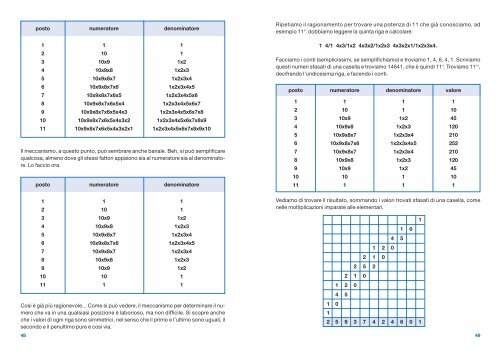Libro - Apprendimenti di base per la scuola in Umbria
Libro - Apprendimenti di base per la scuola in Umbria
Libro - Apprendimenti di base per la scuola in Umbria
You also want an ePaper? Increase the reach of your titles
YUMPU automatically turns print PDFs into web optimized ePapers that Google loves.
posto numeratore denom<strong>in</strong>atore<br />
1 1 1<br />
2 10 1<br />
3 10x9 1x2<br />
4 10x9x8 1x2x3<br />
5 10x9x8x7 1x2x3x4<br />
6 10x9x8x7x6 1x2x3x4x5<br />
7 10x9x8x7x6x5 1x2x3x4x5x6<br />
8 10x9x8x7x6x5x4 1x2x3x4x5x6x7<br />
9 10x9x8x7x6x5x4x3 1x2x3x4x5x6x7x8<br />
10 10x9x8x7x6x5x4x3x2 1x2x3x4x5x6x7x8x9<br />
11 10x9x8x7x6x5x4x3x2x1 1x2x3x4x5x6x7x8x9x10<br />
Il meccanismo, a questo punto, può sembrare anche banale. Beh, si può semplificare<br />
qualcosa, almeno dove gli stessi fattori appaiono sia al numeratore sia al denom<strong>in</strong>atore.<br />
Lo faccio ora.<br />
posto numeratore denom<strong>in</strong>atore<br />
1 1 1<br />
2 10 1<br />
3 10x9 1x2<br />
4 10x9x8 1x2x3<br />
5 10x9x8x7 1x2x3x4<br />
6 10x9x8x7x6 1x2x3x4x5<br />
7 10x9x8x7 1x2x3x4<br />
8 10x9x8 1x2x3<br />
9 10x9 1x2<br />
10 10 1<br />
11 1 1<br />
Così è già più ragionevole... Come si può vedere, il meccanismo <strong>per</strong> determ<strong>in</strong>are il numero<br />
che va <strong>in</strong> una qualsiasi posizione è <strong>la</strong>borioso, ma non <strong>di</strong>fficile. Si scopre anche<br />
che i valori <strong>di</strong> ogni riga sono simmetrici, nel senso che il primo e l’ultimo sono uguali, il<br />
secondo e il penultimo pure e così via.<br />
48<br />
Ripetiamo il ragionamento <strong>per</strong> trovare una potenza <strong>di</strong> 11 che già conosciamo, ad<br />
esempio 11 4 : dobbiamo leggere <strong>la</strong> qu<strong>in</strong>ta riga e calco<strong>la</strong>re:<br />
1 4/1 4x3/1x2 4x3x2/1x2x3 4x3x2x1/1x2x3x4.<br />
Facciamo i conti (semplicissimi, se semplifichiamo) e troviamo 1, 4, 6, 4, 1. Scriviamo<br />
questi numeri sfasati <strong>di</strong> una casel<strong>la</strong> e troviamo 14641, che è qu<strong>in</strong><strong>di</strong> 11 4 . Troviamo 11 10 ,<br />
decifrando l’un<strong>di</strong>cesima riga, e facendo i conti.<br />
posto numeratore denom<strong>in</strong>atore valore<br />
1 1 1 1<br />
2 10 1 10<br />
3 10x9 1x2 45<br />
4 10x9x8 1x2x3 120<br />
5 10x9x8x7 1x2x3x4 210<br />
6 10x9x8x7x6 1x2x3x4x5 252<br />
7 10x9x8x7 1x2x3x4 210<br />
8 10x9x8 1x2x3 120<br />
9 10x9 1x2 45<br />
10 10 1 10<br />
11 1 1 1<br />
Ve<strong>di</strong>amo <strong>di</strong> trovare il risultato, sommando i valori trovati sfasati <strong>di</strong> una casel<strong>la</strong>, come<br />
nelle moltiplicazioni imparate alle elementari.<br />
1<br />
1 0<br />
4 5<br />
1 2 0<br />
2 1 0<br />
2 5 2<br />
2 1 0<br />
1 2 0<br />
4 5<br />
1<br />
1<br />
0<br />
2 5 9 3 7 4 2 4 6 0 1<br />
49


